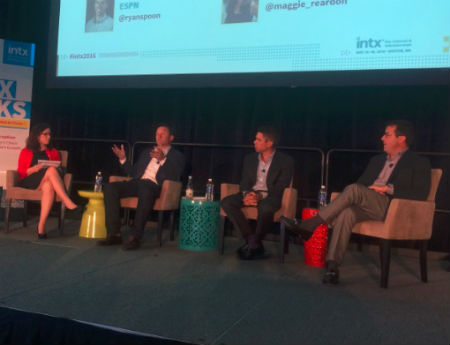INTX 2016: Stop Calling Mobile Video a Trend

Boston -- Whether it’s authenticated TV everywhere services or new direct-to-consumer offerings, mobile video is no longer a funky little trend but a key part of the video and TV landscape that programmers and distributors must continue to focus on and adapt to.
“It’s not a trend. It’s here,” Ryan Spoon, senior vice president, digital product, design and audience development at ESPN, said here Monday at a session titled: “Air Power: Strategies and Sensibilities of the New Mobile Video Marketplace.”
Consumers, added Bob Toohey president of Verizon Digital Media Services (VDMS), simply want content now wherever they happen to be. “There’s no mystery to that,” he said in a panel moderated by CNET’s Maggie Reardon.
But there is some mystery to which distribution models programmers should adopt, whether it’s TVE apps, subscription VOD, or ad-supported services.
Turner is playing in all of those areas, though the rules and windows tend to shift depending on the business model being supported, John Harran, senior vice president of business development, digital distribution and strategic partnerships at Turner, said.
But mobile means different things to different people. Plus, this massive array of distribution and business models can be confusing to consumers, Reardon observed.
Harran agreed that it consumers have more options than ever before, which can make it confusing, but said strong brands, programming and storytelling “cut through that clutter.”
Multichannel Newsletter
The smarter way to stay on top of the multichannel video marketplace. Sign up below.
Spoon said ESPN has endeavored to adapt its content to the various screens, apps and platforms the programmer must now support, noting that programming on its Snapchat channel is filmed in portrait mode.
And Harran said the media world should stop looking at millennials as if they are “creatures from another planet…They are people who like to be entertained.”
Toohey agreed, noting that mobile video is rising in stature not just because it’s how millennial audiences are consuming their content but because all consumers are moving at a faster pace and require quick access to content while they are on the go.
“Mobile often equates to speed…and the user’s mindset,” Spoon agreed, adding that consumers are usually accepting of lower-quality production standards in exchange for more rapid access to that content, such as a video clip from a game-changing moment in a sporting event.
And like millennial audiences, panelists said it’s a mistake to lump social media outlets only to younger audiences.
“The demographics are everyone,” Spoon said. “The numbers are so massive.”
But programmers must be able to tweak and recraft content when they are targeting these various social media outlets, Harran said.
“We are seeing tremendous engagement” on mobile, Harran said, but “No one has cracked the code.”
And building in more personalization will help to support advertising-supported services, Toohey said, referencing Go90, Verizon’s free, ad-supported “mobile-first” OTT service.
Mobile needs to be more personalized, he said, in order to ensure that viewers actually watch the ads, he said.
The panel also weighed in on the controversial topic of mobile data caps and zero-rated services that are exempt from usage-based data policies.
“I look at it and see it as a nice problem to have,” because it means consumers are spending more time watching programming on mobile devices, Harran said.
Toohey said sponsored data is still in its “early” days, but acknowledged that there’s been more change there in the last six months than has been seen in the past three years.
For its part, Verizon in January introduced FreeBee Data, a sponsored data offering that exempts some content from the mobile service operator’s usage-based data caps.
